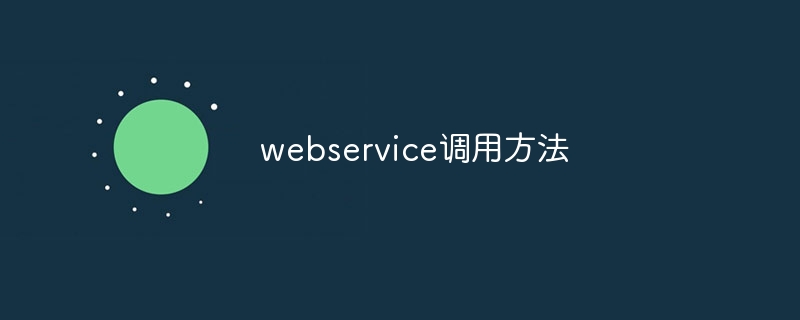
Webservice calling methods include SOAP, REST, JSON-RPC, gRPC and XML-RPC, etc. Detailed introduction: 1. SOAP is an XML-based protocol used for structured data exchange on the network. Calling a SOAP web service requires constructing a SOAP message and using HTTP or other transport protocols to send requests and receive responses. You can use SOAP toolkit to generate client code to call and parse SOAP messages; 2. REST is a protocol based on HTTP and so on.

#Web Service (Web Service) is an application programming interface (API) that communicates over the network. Calling Web services can realize cross-platform and cross-language data exchange and function calls. The following introduces several common Web service calling methods:
1. SOAP (Simple Object Access Protocol): SOAP is an XML-based protocol used for structured data exchange on the network. Calling a SOAP web service requires building a SOAP message and using HTTP or other transport protocols to send requests and receive responses. SOAP toolkits (such as Apache Axis, Apache CXF, etc.) can be used to generate client code to call and parse SOAP messages.
2. REST (Representational State Transfer): REST is an architectural style based on the HTTP protocol and is used to build distributed systems. RESTful web services use HTTP methods (such as GET, POST, PUT, DELETE, etc.) to perform operations on resources. Calling a RESTful web service only requires sending an HTTP request and parsing the data in the response. RESTful web services can be called using HTTP libraries (such as cURL, HttpClient, etc.) or specialized REST client libraries (such as RestTemplate, axios, etc.).
3. JSON-RPC (Remote Procedure Call): JSON-RPC is a lightweight remote procedure call protocol based on JSON format. Calling a JSON-RPC web service requires constructing a JSON-RPC request and using HTTP or other transport protocols to send the request and receive the response. You can use JSON-RPC libraries (such as json-rpc, jsonrpc4j, etc.) to generate client code to call and parse JSON-RPC messages.
4. gRPC (Google Remote Procedure Call): gRPC is a high-performance, open source remote procedure call framework developed by Google. gRPC uses Protocol Buffers as the interface definition language and HTTP/2 as the transport protocol. Calling gRPC services requires generating client and server code, and using gRPC libraries (such as grpc-java, grpc-go, etc.) for calling and parsing.
5. XML-RPC (Remote Procedure Call): XML-RPC is a protocol for remote procedure calls using XML format. Calling an XML-RPC web service requires constructing an XML-RPC request and using HTTP or other transport protocols to send the request and receive the response. XML-RPC libraries (such as xmlrpc, Apache XML-RPC, etc.) can be used to generate client code to call and parse XML-RPC messages.
When calling a Web service, you need to understand the interface definition and usage protocol of the Web service. Usually, Web service providers provide interface documents or WSDL (Web Services Description Language) files to describe the methods, parameters, return values and other information of the Web service. Based on the interface definition, client code can be generated to call the web service.
No matter which calling method is used, you need to pay attention to the security and performance of network communication. The HTTPS protocol can be used to protect the security of communication and perform appropriate performance optimization, such as using caching, compressing data, etc.
In summary, Web service calling methods include SOAP, REST, JSON-RPC, gRPC and XML-RPC, etc. Each method has its characteristics and applicable scenarios. When calling a Web service, you need to understand the interface definition and usage protocol of the Web service, and choose the appropriate calling method and tool as needed.
The above is the detailed content of webservice calling method. For more information, please follow other related articles on the PHP Chinese website!




